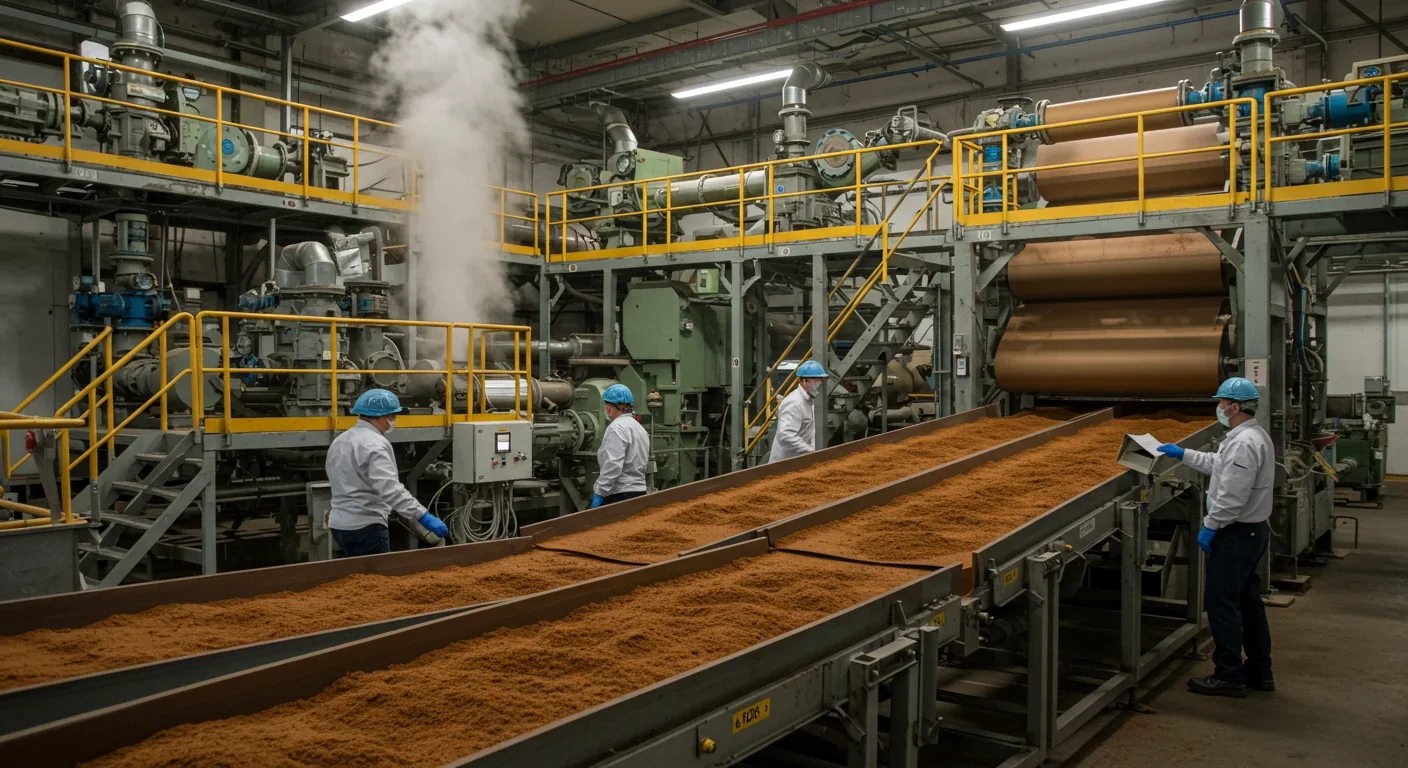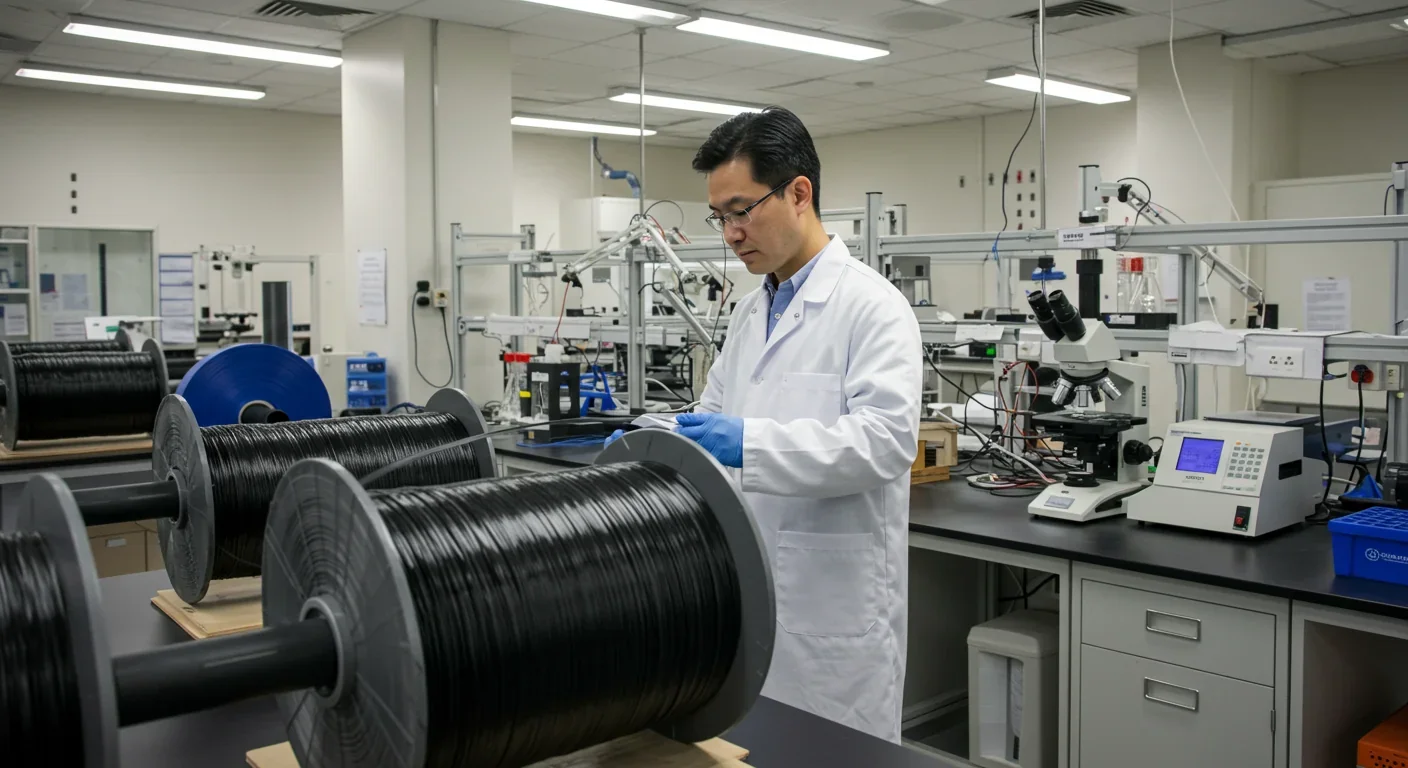Kelp Forests and Climate Change: Marine Permaculture Guide

TL;DR: Scientists have transformed lignin—70 million tonnes of wood waste burned yearly by paper mills—into high-performance carbon fiber that costs 3-5 times less than petroleum-based alternatives while cutting CO₂ emissions by 16.3%. This breakthrough could revolutionize manufacturing from electric vehicles to wind turbines by turning industrial waste into valuable sustainable materials.

Every year, paper mills around the world extract over 70 million tonnes of lignin, the woody glue that holds plants together. Most of it gets burned for energy or dumped as waste. But what if that smokestack fuel could become the backbone of tomorrow's aircraft, the skeleton of electric vehicles, or the frame of wind turbines spinning across distant horizons?
That's not a thought experiment anymore. Researchers have cracked the code on transforming lignin into high-performance carbon fiber, the ultra-strong, feather-light material that currently costs a fortune because it's made from petroleum. The breakthrough doesn't just promise cheaper materials, it flips an entire waste stream into a sustainable manufacturing goldmine.
For decades, carbon fiber has been the darling of aerospace engineers and Formula 1 designers. It's stronger than steel, lighter than aluminum, and wildly expensive. Traditional carbon fiber starts with polyacrylonitrile (PAN), a petroleum-based precursor that requires toxic solvents and energy-intensive processing. The result? Carbon fibers that cost $15-30 per kilogram and generate 23.3 kg of CO₂ emissions for every kilogram produced.
Enter lignin. Scientists at Imperial College London and the University of Manchester have developed a method that replaces up to 90% of petroleum-based precursors with lignin extracted from wood pulp. The process uses ionic liquids, low-cost solvents that are less than a quarter the price of conventional options like DMF and DMSO, to spin continuous lignin fibers up to 5 meters long at pilot-scale facilities.
The numbers are stunning. When researchers replaced 50% of PAN with lignin, carbon emissions dropped to 19.5 kg CO₂ per kilogram of fiber, a 16.3% reduction. Production costs could plummet by three to five times compared to traditional methods. And the lignin content of these fibers exceeds 90%, with carbon yields after pyrolysis topping 50%, making them genuinely cost-competitive.
But the real magic isn't just in the numbers. It's in what this technology does to the entire concept of waste.
Walk into any pulp mill and you'll find lignin everywhere. It's the sticky, complex polymer that gives wood its rigidity, a structural marvel that plants spent millions of years perfecting. When paper manufacturers chemically digest wood chips to extract cellulose, lignin is what's left behind. Traditionally, mills burn it for energy. It works, sort of, but it's like using a Rembrandt to heat your house.
Lignin's chemical structure, rich in aromatic rings and carbon-carbon bonds, makes it an ideal precursor for carbon fiber. The challenge has always been processing it. Lignin doesn't dissolve easily, it's heterogeneous (every tree species produces slightly different lignin), and it doesn't spin into fibers as cleanly as PAN. For years, those obstacles kept lignin relegated to the boiler room.
The Imperial College team solved the spinning problem by integrating carbon nanotubes (CNTs) into the lignin solution. The CNTs act like microscopic scaffolding, improving the graphitic structure of the final fiber and reducing the energy needed for pyrolysis, the high-temperature process that converts precursor fibers into carbon fiber. Meanwhile, the low-cost ionic liquid solvent dissolves lignin efficiently, enabling continuous fiber production at scales that matter commercially.
At Manchester's pilot facility, researchers tested three different types of lignin and achieved fibers with 75-90% lignin content, excellent structural quality, and yields that work for industrial manufacturing. Professor Jonny Blaker's team demonstrated that lignin-based carbon fiber isn't a laboratory curiosity—it's a scalable reality.
Making carbon fiber from lignin involves four key stages, each engineered to coax maximum performance from a material that nature designed for entirely different purposes.
First comes extraction. Most lignin comes from Kraft pulping, the dominant method in paper manufacturing. Kraft lignin accounts for 45.2% of the global lignin market thanks to its high purity and thermal stability. Mills extract it during chemical digestion of wood, then isolate it through acidification and filtration. The result is a brown powder, rich in carbon and ready for transformation.
Next is spinning. Traditional PAN-based carbon fiber uses toxic solvents at high temperatures. Lignin's new approach uses ionic liquids, which are salts that remain liquid at room temperature. These solvents dissolve lignin at lower temperatures and with far less toxicity. The lignin-ionic liquid solution (the "dope") gets extruded through tiny nozzles into a water bath, where it solidifies into continuous fibers. Adding CNTs to the dope improves fiber alignment and strength.
The third stage, thermostabilization, is where chemistry gets serious. The lignin fibers are heated in air at 200-300°C, triggering oxidation reactions that cross-link the polymer chains and prevent them from melting in the next step. This phase is energy-intensive and accounts for a significant portion of the process's carbon footprint, but it's essential for structural integrity.
Finally comes carbonization. The stabilized fibers are heated to 1000-1500°C in an inert atmosphere (usually nitrogen), driving off everything that isn't carbon. What remains is a fiber with a graphitic structure, the interlocking hexagonal lattice of carbon atoms that gives carbon fiber its legendary strength-to-weight ratio. Lignin-based fibers achieve carbon yields above 50%, meaning more than half the precursor's mass survives as pure carbon, a respectable figure that makes the economics work.
The real breakthrough is that this entire process costs dramatically less than PAN-based production. Lignin is essentially free (mills currently pay to dispose of it), ionic liquids are cheaper than conventional solvents, and the energy requirements for thermostabilization and carbonization are comparable or lower thanks to CNT-enhanced graphitic ordering.

Lignin-based carbon fiber is poised to open markets that traditional carbon fiber can't touch because of cost. Automotive manufacturers are first in line. Reducing vehicle weight by 10% can boost fuel efficiency or electric range by 6-8%, a game-changer when every mile matters for emissions regulations and consumer appeal. High-end cars already use carbon fiber in limited applications, but lignin-based alternatives could make it economical for mass-market vehicles: door panels, interior structures, even body panels.
Wind turbine blades represent another massive opportunity. Longer blades capture more wind energy, but they need to be light enough to avoid structural failure. Carbon fiber is ideal, but cost has limited adoption. Lignin-based fiber could slash blade production costs, enabling longer, more efficient turbines that generate more clean energy per installation.
Then there's infrastructure. Concrete reinforced with lignin-based carbon fiber could last decades longer than steel-reinforced concrete, which corrodes over time. Lignin additives already serve as plasticizers and binders in concrete, improving workability and durability while reducing cement consumption. Combining lignin's dual roles as additive and reinforcement could revolutionize sustainable construction.
Sports equipment, aerospace components, hydrogen fuel tanks, and even landscape timber structures could all benefit. The common thread is that lignin-based carbon fiber is good enough for most applications, even if it doesn't yet match the absolute highest-performance grades used in fighter jets or Formula 1 chassis. But "good enough" at one-fifth the cost is a market revolution.
There's also the circular economy angle. Paper mills generate waste, and manufacturers need materials. Connecting those dots turns a disposal problem into a value stream. AFRY's research shows that mills can optimize lignin extraction without disrupting cellulose production, creating a new revenue source from existing infrastructure. As one market analyst put it, "Lignin is no longer just a by-product—it's a resource with enormous potential".
Not everything is smooth sailing. Lignin's heterogeneity remains a technical challenge. Different tree species, pulping methods, and even seasonal variations produce lignin with different chemical compositions. That variability affects fiber properties, and manufacturers need consistency. Researchers are working on standardized blending protocols and pre-treatment methods to homogenize lignin feedstocks, but it's not trivial.
Performance gaps also exist. Lignin-based carbon fiber typically achieves tensile strengths of 1-2 GPa, compared to 3-7 GPa for top-tier PAN-based fibers. That's fine for automotive and wind applications, where cost matters more than ultimate strength, but aerospace and defense still require PAN. Bridging that performance gap will require further innovations in fiber alignment, graphitic ordering, and heat treatment.
Energy consumption is another issue. While lignin-based processes reduce emissions by 16.3%, electricity still dominates the carbon footprint. Thermostabilization and carbonization are inherently energy-intensive. The environmental benefits of lignin-based fiber depend heavily on using low-carbon electricity. A mill powered by coal negates much of the sustainability advantage, while one using hydropower or renewables amplifies it.
Scaling presents logistical challenges. Pilot facilities produce kilograms of fiber; commercial demand is measured in tonnes. Scaling up wet spinning, ensuring uniform quality across long production runs, and integrating lignin supply chains with fiber manufacturing all require capital investment and engineering expertise. Early adopters will face higher costs and learning curves.
There's also the question of market inertia. Industries that have optimized around PAN-based carbon fiber won't switch overnight. Certification processes for aerospace and automotive applications are rigorous and slow. Suppliers, manufacturers, and end users all need convincing that lignin-based fiber performs as advertised. That takes time, testing, and trust.
The lignin carbon fiber story isn't unfolding in isolation. It's part of a broader global shift toward bio-based materials, circular economies, and decarbonized manufacturing. Different regions are approaching this transition with distinct strategies, and the outcomes will shape who leads the next generation of advanced materials.
Europe is moving fast. The Green Chemistry study that quantified lignin's emissions reductions came from European researchers, and the UK's Imperial College and University of Manchester collaborations are attracting industry partnerships. Lixea, the industrial partner behind Imperial's pilot-scale production, is positioning itself to commercialize the technology. European policymakers are backing bio-based materials through funding programs and carbon pricing mechanisms that make fossil-based alternatives more expensive.
Asia-Pacific is ramping up capacity. China, the world's largest carbon fiber producer, is investing heavily in lignin research. With a projected CAGR of 8.4% in the lignin waste market, China sees bio-based precursors as a way to reduce dependence on imported petroleum and capture value from its massive forestry and paper industries. India, with a 7.8% CAGR, is similarly focused on sustainable materials to support its growing manufacturing sector.
North America is hedging. The U.S. lignin market is estimated at $364.9 million in 2025, projected to reach $609.9 million by 2035. American research institutions are exploring lignin valorization, but commercial deployment lags behind Europe. Part of that reflects lower carbon prices and less regulatory pressure to decarbonize, but it also signals a wait-and-see approach. U.S. manufacturers may adopt lignin-based fibers once European and Asian competitors prove the economics.
There's also competition from other bio-based precursors. Cellulose, algae, and even waste textiles are being explored as carbon fiber feedstocks. Lignin has the advantage of volume (70 million tonnes per year is a lot of feedstock) and existing industrial infrastructure, but the race for bio-based carbon fiber is wide open.
Geopolitical implications matter too. Carbon fiber is a strategic material, used in military aircraft, missiles, and armored vehicles. Countries that control advanced materials supply chains gain economic and security advantages. If lignin-based carbon fiber achieves cost parity with PAN at scale, nations with large forestry sectors and paper industries could become new materials superpowers. Think Sweden, Finland, Canada, Russia, and Brazil.
Climate diplomacy also plays a role. International agreements like the Paris Accord and the EU's Carbon Border Adjustment Mechanism incentivize low-carbon manufacturing. Lignin-based carbon fiber, with its reduced emissions profile, could become a preferred material for exports to carbon-conscious markets. Conversely, countries that stick with fossil-based precursors may face tariffs and trade barriers.

So what happens when carbon fiber stops being a luxury and becomes ubiquitous? When the material that defined high-tech exclusivity shows up in everyday objects?
For engineers and designers, lignin-based carbon fiber means rethinking what's possible. Products too expensive to make with PAN-based composites suddenly become viable. That electric scooter you ride? Its frame could weigh half as much. The bridge in your city? It could be reinforced with carbon fiber that outlasts steel by decades. The packaging for fragile goods? Lightweight, strong, and compostable if researchers can close the loop on end-of-life recycling.
For manufacturers, the shift demands new supply chains. Paper mills become materials suppliers. Chemical companies develop specialized ionic liquids. Equipment manufacturers build wet-spinning lines optimized for lignin. The convergence of forestry, chemistry, and advanced materials creates industries that didn't exist a decade ago.
For policymakers, lignin-based carbon fiber is a test case for circular economy principles. Can waste streams become value streams at scale? Can bio-based materials displace fossil-based incumbents? The answers depend on policy choices: carbon pricing, R&D funding, procurement standards, and international collaboration. Governments that get this right could anchor new industrial clusters and export markets.
For all of us, the message is simpler. The future isn't always flashy. Sometimes it's about seeing potential where others see waste, about asking whether the stuff we throw away could be the stuff we need. Lignin spent eons holding forests together. Now it might just hold our sustainable future together too.
The woodshop waste isn't waste anymore. It's a wonder material waiting for its moment. And judging by the progress in labs and pilot facilities from Manchester to Tokyo, that moment is arriving faster than anyone expected.
When the next generation looks back, they might find it strange that we ever burned such a valuable resource. They'll see lignin-based carbon fiber in their cars, their buildings, their infrastructure, and wonder why it took us so long to figure out what trees knew all along: that the strongest structures start with the humblest materials.

Saturn's iconic rings are temporary, likely formed within the past 100 million years and will vanish in 100-300 million years. NASA's Cassini mission revealed their hidden complexity, ongoing dynamics, and the mysteries that still puzzle scientists.

Scientists are revolutionizing gut health by identifying 'keystone' bacteria—crucial microbes that hold entire microbial ecosystems together. By engineering and reintroducing these missing bacterial linchpins, researchers can transform dysfunctional microbiomes into healthy ones, opening new treatments for diseases from IBS to depression.

Marine permaculture—cultivating kelp forests using wave-powered pumps and floating platforms—could sequester carbon 20 times faster than terrestrial forests while creating millions of jobs, feeding coastal communities, and restoring ocean ecosystems. Despite kelp's $500 billion in annual ecosystem services, fewer than 2% of global kelp forests have high-level protection, and over half have vanished in 50 years. Real-world projects in Japan, Chile, the U.S., and Europe demonstrate economic via...

Our attraction to impractical partners stems from evolutionary signals, attachment patterns formed in childhood, and modern status pressures. Understanding these forces helps us make conscious choices aligned with long-term happiness rather than hardwired instincts.

Crows and other corvids bring gifts to humans who feed them, revealing sophisticated social intelligence comparable to primates. This reciprocal exchange behavior demonstrates theory of mind, facial recognition, and long-term memory.

Cryptocurrency has become a revolutionary tool empowering dissidents in authoritarian states to bypass financial surveillance and asset freezes, while simultaneously enabling sanctioned regimes to evade international pressure through parallel financial systems.

Blockchain-based social networks like Bluesky, Mastodon, and Lens Protocol are growing rapidly, offering user data ownership and censorship resistance. While they won't immediately replace Facebook or Twitter, their 51% annual growth rate and new economic models could force Big Tech to fundamentally change how social media works.